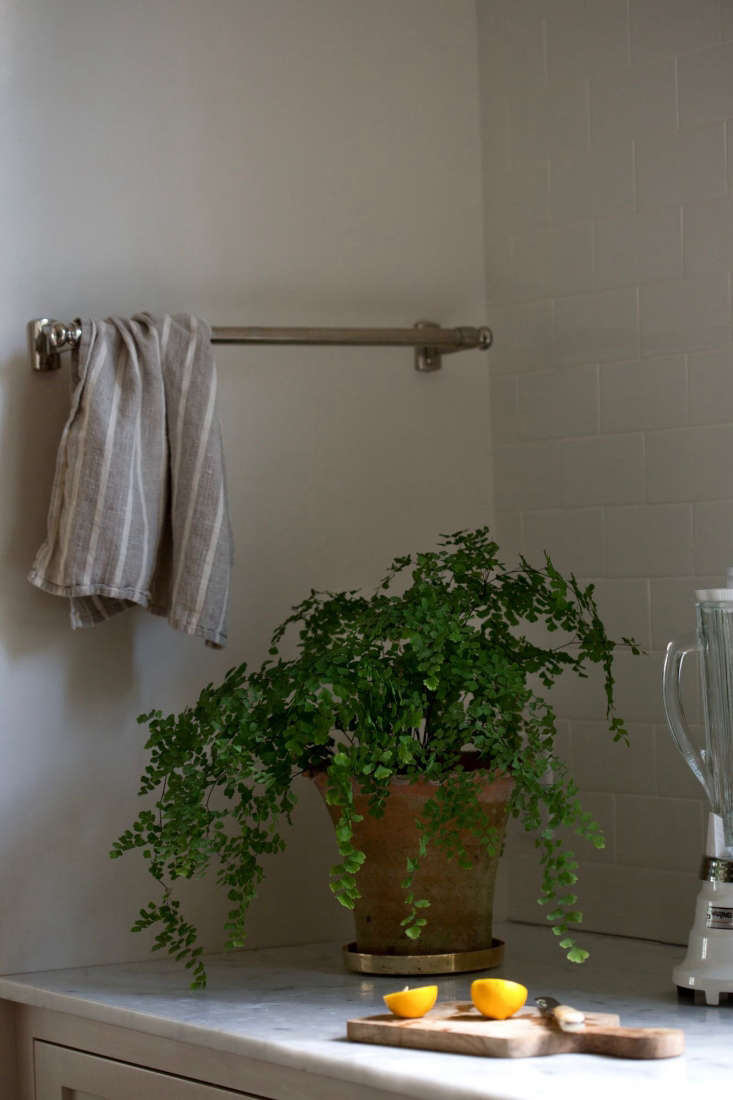Indoor plants is an oxymoron. The most important thing to know about plants: they prefer to live outdoors. You will never see a botanical description that starts with “native to north-facing windowsills” because the concept of “houseplants” is something humans made up.
So when we talk about the best indoor plants for “low-light conditions,” what we really are trying to identify is the plants most tolerant of living in a dark apartment with one wall of windows (or possibly, one window).
The good news is plenty of plants can thrive in a dark apartment. They may not love it, but they will adapt—especially if you coddle them with extra light from time to time (if possible bring them outdoors to enjoy warm weather in a sheltered, shady spot).
Here are nine favorite indoor plants for low-light conditions:
Photography by Mimi Giboin.
Maidenhair Fern

Care and Feeding: Keep a maidenhair fern out of direct sunlight, which can singe its lacy fronds. Keep the soil moist. Let me repeat that: Keep. The. Soil. Moist. (If you forget and it dries out for 10 seconds and your fern turns all brown and crinkly, don’t give up hope—cut away the dead foliage, keep the soil moist, and the fern probably will send up new growth).
Design Tip: If ever there was a houseplant situation that cried out for a self-watering pot, this is it. See some of our favorites in 10 Easy Pieces: Self-Watering Pots and Planters.
Moth Orchid

Botanical Name: Phalaenopsis
Care and Feeding: Your moth orchid dislikes direct sunlight and should be potted in a mix of pine bark or sphagnum peat moss (not potting soil). Water it once every 7 to 10 days (poke your finger into the planter to make sure it’s dry to a depth of 1 inch before watering). Humidity makes orchids happy; bring yours into the bathroom when you shower.
Design Tip: Leave your orchid in the plastic nursery pot and set that pot into a decorative planter (as above). This makes it easy to water the orchid—just set the plastic pot in the sink when it’s time—and gives you the option to display it in an urn or vase that has no drainage holes.
Prayer Plant

Care and Feeding: A native of the tropics, Calathea likes moisture and well-drained soil. Avoid direct sunlight (it fades the pattern on the leaves) and mist its leaves if the air in your home is very dry.
Design Tip: The weak sunlight of a north-facing windowsill in a bathroom would be a happy home for this plant.
Asparagus Fern

Care and Feeding: Asparagus ferns enjoy warm days and cool nights; they’ll welcome a temperature change of 10 degrees so turn down the heat if possible when you go to sleep. Keep your plant out of direct sunlight and if the air is dry, perk up an asparagus fern by placing it next to a humidifier.
Design Tip: Lacy, draping foliage makes an asparagus fern a good candidate for a hanging pot.
Waffle Plant

Care and Feeding: Keep waffle plant out of direct sunlight, let the surface of the soil dry before watering it, and make sure the soil drains well.
Design Tip: This creeper with crinkly, puckered leaves adds texture and color to any room.
Angel Vine

Care and Feeding: Avoid direct sunlight or a harsh western exposure. Fertilize every month and allow the soil to dry out before water.
Design Tip: Muehlenbeckias hail from a humid climate and to keep them from drying out in indoor air, place near an open window or doorway that opens onto fresh air.
Mother in Law’s Tongue

Care and Feeding: Nicknamed “the houseplant you cannot kill,” Sansevieria is tough enough to live under your bathroom sink for extended periods of time. (Do reward it from time to time with some indirect sunlight.) A succulent, it retains water in its leaves; don’t drown it by over-watering.
Design Tip: Its vertical habit has a sculptural effect; place it on a stairway landing, or brighten a dark corner with Sansevieria.
English Ivy

Care and Feeding: Improve the drainage of ivy’s soil with a shallow layer of pebbles at the bottom of the pot, avoid direct sunlight, and let the soil dry out between waterings.
Design Tip: This vine is at its most dramatic when allowed to spill over the edge of a shelf or tabletop.
Lemon Button Fern

Botanical Name: Nephrolepis cordifolia ‘Duffii’
Care and Feeding: Keep soil moist, provide a shady perch, and fertilize it once a week during spring and summer.
Design Tip: With a compact, tidy shape, this fern looks best on a shelf, with a wall behind it to frame its delicate fronds.
The Lineup

Is the cold weather inspiring you to bring a houseplant (or two) into your life? See more of our favorites:
- 7 Secrets: How to Save a Dying Fiddle Leaf Fig Tree.
- Expert Advice: 10 Best Low-Maintenance Houseplants.
- Garden Design 101 Guide to Houseplants.
- 5 Houseplants That Changed History.
- Plant Guide: Fiddle Leaf Fig Tree.
- The Orchid That Owned Me.
Finally, get more ideas on how to plant, grow, and care for various houseplants with our Houseplants: A Field Guide.



















Have a Question or Comment About This Post?
Join the conversation (9)